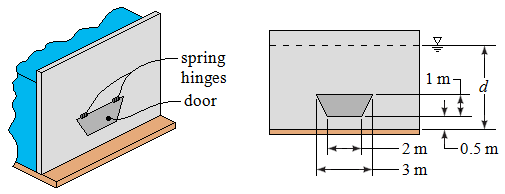| Moment of Inertia and Couples |
Problem
A vertical trapezoidal door used as an automatic valve is held shut by two spring hinges as shown. Knowing that each spring exerts a couple of magnitude 9 kNm, determine the depth d of water for which the door will open.

Solution
Nomenclature
| Fp | pressure force |
| γ | specific weight |

h |
| vertical distance from centroid of trapezoid area to top of water |
| A | area |

y |
| vertical distance from centroid to trapezoid edge with the springs (centroid distance) |
The water exerts a pressure on the door. The pressure on the door due to the water is dependent on the depth of the water. Pressure times area is force (see stress). Force times distance is moment. The couple given in the problem is equivalent to moment. The force of the pressure on the door can be summed up as a resultant. The resultant acts at a location to create equivalent effect as the pressure on the door. The perpendicular distance from this point to the edge of the door where the springs are at is the distance to be multiplied times the pressure force to result in the moment that is equal to the moment due to the springs. Where does the distance d come into play? Well the depth of the water has to be such that the moment caused by the pressure force is equal to the couple caused by the springs. When the moment caused by the pressure force begins to become greater than the couple caused by the springs the door will begin to open.
Each spring has a couple of 9 kNm, so the total due to both is 18 kNm. This is set equal to the moment caused by the pressure on the door:
18 kNm = Fpdm
First lets find the pressure force.
Fp = γ
h |
A
Because of the definition of 
h |
in the nomenclature above, a distance d1 will be designated since:

h |
= d1 + 
y |
Why do this? Because 
y |
is the centroid distance, and there are tables for centroid distances. The centroid distance for 
y |
follows:

y |
= | |

y |
= 0.4667 m
The area is:
A = 0.5h(a + b)
A = 2.5 m2
The equation for the force is then:
Where all variables are known except for d1, which is the variable of interest.
The location for the center of the pressure force is:
| yp = | | I'x | A
h |
|
| + 
h |
|
I'x is:
| I'x = | | h3(a2 + 4ab + b2) | | 36(a + b) |
|
I'x = 0.20555 m4
and:
dm = yP − d1
Then:
| dm = | | 0.20555 m4 | | (2.5 m2)*(d1 + 0.4667 m) |
| + d1 + 0.4667 m − d1 |
Then, writing the moment equation:
| dm = | | 0.20555 m4 | | (2.5 m2)*(d1 + 0.4667 m) |
| + d1 + 0.4667 m − d1 |









